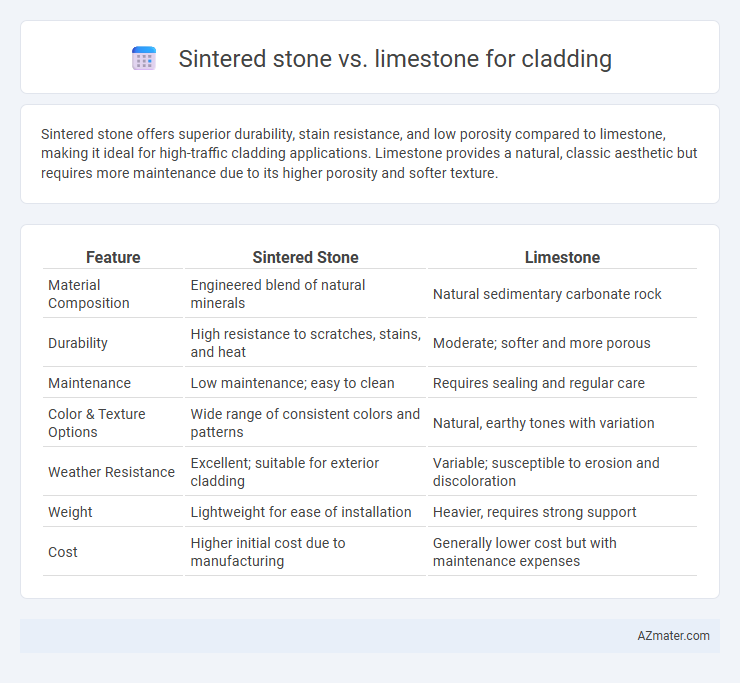Sintered stone offers superior durability, stain resistance, and low porosity compared to limestone, making it ideal for high-traffic cladding applications. Limestone provides a natural, classic aesthetic but requires more maintenance due to its higher porosity and softer texture.
Table of Comparison
| Feature | Sintered Stone | Limestone |
|---|---|---|
| Material Composition | Engineered blend of natural minerals | Natural sedimentary carbonate rock |
| Durability | High resistance to scratches, stains, and heat | Moderate; softer and more porous |
| Maintenance | Low maintenance; easy to clean | Requires sealing and regular care |
| Color & Texture Options | Wide range of consistent colors and patterns | Natural, earthy tones with variation |
| Weather Resistance | Excellent; suitable for exterior cladding | Variable; susceptible to erosion and discoloration |
| Weight | Lightweight for ease of installation | Heavier, requires strong support |
| Cost | Higher initial cost due to manufacturing | Generally lower cost but with maintenance expenses |
Introduction to Cladding Materials
Sintered stone offers superior durability, low porosity, and resistance to UV rays, making it ideal for exterior cladding applications compared to traditional limestone. Limestone, while valued for its natural texture and aesthetic appeal, tends to be more porous and susceptible to weathering and staining. Choosing sintered stone enhances longevity and requires less maintenance, making it a practical choice for modern architectural facades.
What is Sintered Stone?
Sintered stone is an engineered material composed of natural minerals fused together under extreme heat and pressure, resulting in a dense, durable surface ideal for cladding. Unlike limestone, which is a sedimentary rock prone to weathering and erosion, sintered stone offers superior resistance to scratches, stains, UV rays, and temperature fluctuations. This makes sintered stone a highly suitable choice for both interior and exterior cladding applications where longevity and low maintenance are critical.
What is Limestone?
Limestone is a sedimentary rock composed primarily of calcium carbonate, commonly used in building and cladding due to its natural durability and aesthetic appeal. It offers a distinctive texture and color variation that adds warmth and character to exterior facades. Compared to sintered stone, limestone is more porous and susceptible to weathering, requiring regular maintenance to preserve its appearance over time.
Key Differences: Sintered Stone vs Limestone
Sintered stone offers superior durability, resistance to scratches, stains, and UV rays compared to limestone, making it ideal for exterior cladding in harsh environments. Limestone, a natural sedimentary rock, provides unique texture and warmth with its porous structure but requires regular sealing to prevent weathering and erosion. The low maintenance and higher strength of sintered stone distinguish it as a modern alternative to the traditional aesthetic and softer nature of limestone in architectural cladding applications.
Durability and Strength Comparison
Sintered stone offers superior durability and resistance to scratches, stains, and weathering compared to limestone, making it an ideal choice for cladding in harsh environments. Limestone, while aesthetically pleasing with its natural texture, is softer and more porous, requiring regular maintenance to prevent erosion and damage over time. The high density and compact structure of sintered stone provide greater strength, ensuring longevity and minimal degradation in exterior applications.
Aesthetic Appeal and Design Versatility
Sintered stone offers superior aesthetic appeal and design versatility compared to limestone due to its wide range of colors, textures, and patterns that mimic natural materials while providing greater uniformity. Its durability and resistance to UV rays, scratches, and stains enable designers to create sleek, modern facades with consistent finishes, unlike limestone which may weather unevenly and require more maintenance. The flexibility of sintered stone in large-format panels and slim profiles allows for innovative architectural applications, whereas limestone is often limited by traditional cut sizes and susceptibility to surface erosion.
Maintenance and Longevity
Sintered stone offers superior durability and low maintenance compared to limestone, as it is highly resistant to scratches, stains, and weathering, ensuring long-lasting performance with minimal upkeep. Limestone, while aesthetically appealing, is porous and more susceptible to erosion, staining, and damage from acidic substances, requiring regular sealing and careful maintenance. The enhanced hardness and chemical resistance of sintered stone make it a more cost-effective and durable choice for cladding applications over time.
Environmental Impact and Sustainability
Sintered stone offers superior environmental benefits over limestone by utilizing natural raw materials compressed under high temperatures and pressures, resulting in a durable, non-porous surface that requires minimal maintenance and no chemical sealants. Limestone extraction significantly disrupts ecosystems and involves energy-intensive quarrying processes producing high carbon emissions, whereas sintered stone manufacturing incorporates recycled materials and consumes less water. Choosing sintered stone for cladding enhances sustainability through longer lifespan, recyclability, and reduced ecological footprint compared to the slower-renewing and more resource-intensive limestone.
Cost Analysis and Budget Considerations
Sintered stone typically costs more than limestone due to its advanced manufacturing process and enhanced durability, making it a long-term investment in cladding projects. Limestone offers a more affordable initial price but may incur higher maintenance expenses over time due to its porous nature and susceptibility to weathering. Evaluating the total cost of ownership, including installation, upkeep, and lifespan, is crucial for budget-conscious decisions in exterior cladding applications.
Which is Better for Cladding: Sintered Stone or Limestone?
Sintered stone outperforms limestone for cladding due to its superior durability, resistance to stains, and minimal maintenance requirements, making it ideal for both exterior and interior applications. Limestone, while aesthetically appealing with its natural texture and warmth, is more porous and prone to weathering, requiring regular sealing and care to maintain its appearance. For projects demanding longevity and low upkeep, sintered stone provides a more reliable and cost-effective cladding solution.

Infographic: Sintered stone vs Limestone for Cladding
 azmater.com
azmater.com